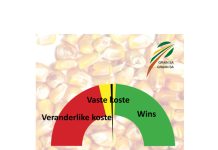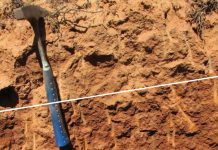



Scientific name: Avena fatua
Afrikaans name: Wildehawer
English name: Wild oats
Short description
Wild oats is an annual (annual = goes through whole life cycle within a year) grass, which can grow between 60 – 90 cm tall. The stems are solitary or often tufted. The culms are erect and hairless and has two to five nodes.
The leaf sheaths are also hairless and can grow as long as 20 cm. The leaves, which are also hairless, are linear and have sharp apices and can grow up to 24 cm long and 8 mm wide. The ligule is membranous and can be up to 6 mm long.
The inflorescence of wild oats is open, loose panicles that can grow up to 40 cm long. The spikelets are oblong, narrow, gaping and contain two to three florets. Each lemma has a bent and twisted awn, with a darkly coloured underside.
The seeds look like typical oat seeds and are straw-coloured, hairy and rounded on the one side and clefted on the other side. The seed can be 9 mm long and 2 mm wide.
Distribution
Wild oats is a severe competitor and commonly occur in the Southern Cape Province and the grain producing areas of the Free State, especially in monoculture wheat production. The seed of wild oats is usually distributed through contaminated wheat seed and contaminated machinery (like combines).
Control
Chemical
Post-emergence herbicides are applied after the weed and/or crop has emerged from the soil. Several herbicides are registered for the control of wild oats in wheat (Table 1 and Table 2).
Always strictly follow the specific instructions and dosage recommendations on the product’s label.
TABLE 1: Herbicides registered on maize for the control of wild oats.
| Active ingredient | Formula | Time of application |
|---|---|---|
| bromoxynil | 450 g/litre | Post-emergence when seedlings are between three and six leaf stage |
| glyphosate/mesotrione/s-metolachlor | 250/25/250 g/litre | Apply only on glyphosate resistant maize cultivars, early post-emergence of the weed |
TABLE 2: Herbicides registered on wheat for the control of wild oats.
| Active ingredient | Formula | Time of application |
|---|---|---|
| bromoxynil | 450 g/litre | Post-emergence when seedlings are between three and six leaf stage |
| clodinafop-propargyl | 240 g/litre | Post-emergence when seedlings are between three and six leaf stage. Dosage rate will depend on weed species and application method |
| diclofop-methyl | 378 g/litre | ONLY use in irrigated wheat. Apply before the crop reaches the five leaf stage |
| fenoxaprop-P-ethyl | 120 g/litre | Apply when weeds are in the three to five leaf stage. Dosage depends on weed species, growth stage and method of application |
| flucarbazone-sodium | 700 g/kg | Wheat in leaf stage three to five |
| iodosulfuron-methyl-sodium/ mefenpyrdiethyl | 50/150 g/kg | Post-emergence when seedlings are between two and three leaf stage |
| iodosulforon-methyl-sodium/ metsulfuron-methyl/mefenpyr-diethyl | 30/30/90 g/kg | Post-emergence application up until the fourth leaf stage (only in winter rainfall region) |
| pinoxaden | 45 g/litre | Dosage depends on the grass species |
| pyroxsulam | 45 g/litre | Post-emergence, two to three leaf stage of wheat until the second node stage, but when wild oats are still in the seedling stage |
| sulfosulfuron | 750 g/kg | Post-emergence, one to four leaf stage of the weed. Dosage rate will depend on weed species |
| tralkoxydim | 100 g/litre | Post-emergence, two to four leave stage of the weed (winter rainfall region) Post-emergence, two to four leave stage of weed (Summer rainfall region or irrigation wheat) |
| triallate | 480 g/litre | Pre-emergence, apply to well-prepared seedbed prior to planting and incorporate with planter within four hours |
| triasulfuron | 750 g/kg | Apply at planting |
Cultivation
In the winter rainfall area cultivation (ploughing) can help to lessen the problem, but this can only be done if no winter wheat was planted. Because wild oats seed have the ability to stay dormant in the soil for up to nine years, crop rotation is not very effective for the control of this weed. Also, it is very difficult to control this weed chemically in winter wheat under dryland conditions and selective post-emergence herbicides have to be used.
Herbicide resistance in this weed has been documented and poor control has been reported from all over South Africa. Producers and chemical advisors must always take herbicide resistance into account when making herbicide recommendations. Never use products to which resistance has been noted on specific fields/farms. Always contact a reliable chemical advisor before buying and/or using any chemicals and strictly follow the label instructions.
Contact the writers at elbe.hugo@syngenta.com (Elbe Hugo) and, deweth@arc.agric.za (Hestia Nienaber).

















